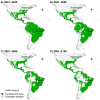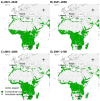Global Distribution of Aedes aegypti and Aedes albopictus in a Climate Change Scenario of Regional Rivalry
- PMID: 36661976
- PMCID: PMC9860750
- DOI: 10.3390/insects14010049
Global Distribution of Aedes aegypti and Aedes albopictus in a Climate Change Scenario of Regional Rivalry
Abstract
Arboviral mosquito vectors are key targets for the surveillance and control of vector-borne diseases worldwide. In recent years, changes to the global distributions of these species have been a major research focus, aimed at predicting outbreaks of arboviral diseases. In this study, we analyzed a global scenario of climate change under regional rivalry to predict changes to these species' distributions over the next century. Using occurrence data from VectorMap and environmental variables (temperature and precipitation) from WorldClim v. 2.1, we first built fundamental niche models for both species with the boosted regression tree modelling approach. A scenario of climate change on their fundamental niche was then analyzed. The shared socioeconomic pathway scenario 3 (regional rivalry) and the global climate model Geophysical Fluid Dynamics Laboratory Earth System Model v. 4.1 (GFDL-ESM4.1; gfdl.noaa.gov) were utilized for all analyses, in the following time periods: 2021-2040, 2041-2060, 2061-2080, and 2081-2100. Outcomes from these analyses showed that future climate change will affect Ae. aegypti and Ae. albopictus distributions in different ways across the globe. The Northern Hemisphere will have extended Ae. aegypti and Ae. albopictus distributions in future climate change scenarios, whereas the Southern Hemisphere will have the opposite outcomes. Europe will become more suitable for both species and their related vector-borne diseases. Loss of suitability in the Brazilian Amazon region further indicated that this tropical rainforest biome will have lower levels of precipitation to support these species in the future. Our models provide possible future scenarios to help identify locations for resource allocation and surveillance efforts before a significant threat to human health emerges.
Keywords: Aedes; climate change; climate models; environmental indicators; forecasting; risk factors; statistical model.
Conflict of interest statement
The authors declare that they have no conflict of interest regarding the publication of this paper. The view(s) expressed in this article are those of the authors and do not necessarily reflect the official policy or position of the Departments of the Army, Air Force, or Navy, the Department of Defence, or the U.S. Government. The use of trade names in this document does not constitute an official endorsement or approval of the use of such commercial hardware or software. Do not cite this document for advertisement. The publication has been cleared for publication by the Walter Reed Army Institute of Research (WRAIR).
Figures








References
-
- Oliveira W.K., Cortez-Escalante J., De Oliveira W.T.G.H., do Carmo G.M.I., Henriques C.M.P., Coelho G.E., Araújo de França G.V. Increase in Reported Prevalence of Microcephaly in Infants Born to Women Living in Areas with Confirmed Zika Virus Transmission During the First Trimester of Pregnancy—Brazil, 2015. MMWR Morb. Mortal. Wkly. Rep. 2016;65:242–247. doi: 10.15585/mmwr.mm6509e2. - DOI - PubMed
Grants and funding
LinkOut - more resources
Full Text Sources

